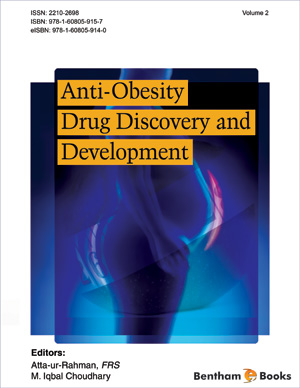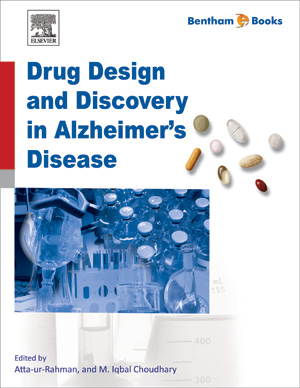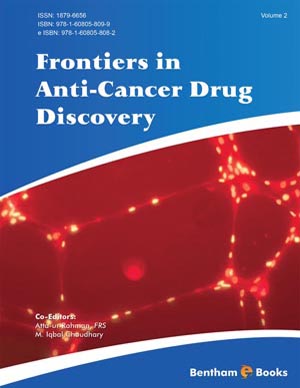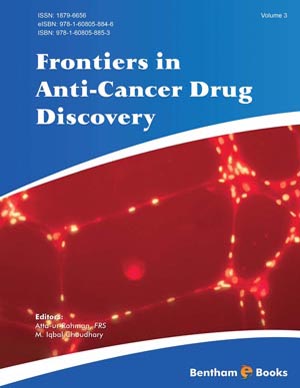Book Volume 2
Preface
Page: i-iii (3)
Author: Atta-ur-Rahman and M. Iqbal Choudhary
DOI: 10.2174/9781608059140114020001
List of Contributors
Page: iv-v (2)
Author: Atta-ur-Rahman and M. Iqbal Choudhary
DOI: 10.2174/9781608059140114020002
An Approach to Obesity as a Cardiometabolic Disease: Potential Implications for Clinical Practice
Page: 3-85 (83)
Author: José Sabán-Ruíz, Martin Fabregate-Fuente, Rosa Fabregate-Fuente, Ana Alonso-Pacho, Cristina de la Puerta González-Quevedo, Susana Tello Blasco, Asunción Guerri and Alcira Andrés and Delia Barrio
DOI: 10.2174/9781608059140114020003
PDF Price: $30
Abstract
Obesity is a multifactorial disease that is currently developing a threatening tendency towards becoming the main cause of chronic disease in the world. Obesity can induce type 2 diabetes mellitus, dyslipidemia, cardiovascular disease and other chronic disorders with high social and health costs. Obesity was firstly described in 2000 as a cardiometabolic disease, even before Metabolic Syndrome, type 2 diabetes mellitus and coronary disease were considered as such. In this chapter we recover this approach to obesity, which has remained almost forgotten for the last decade. In obese subjects, adipokines and miokines interact to promote reticulum stress, insulin resistance, metabolic inflexibility and endothelial dysfunction. These pathological processes are amplified when hyperglycemia is present, leading to an increased risk for atherosclerosis. A number of potential implications for clinical practice are derived from the cardiometabolic state underlying obesity and its comorbidities. The first step in the therapeutic strategy against obesity should be the correct diagnosis of its causes and the promotion of lifestyle changes including physical exercise and a healthy diet. In the usual case of failing to achieve results, we can still resort to the pharmacological therapy. While awaiting the release of new drugs, topiramate, alone or combined with phentermine, has been proposed as a novel anti-obesity drug, showing relevant effects not only on weight loss but also on cardiometabolic alterations and biomarkers, even though new studies should clarify the mechanisms of these findings. Finally, our own experience with topiramate is described, focusing on its effects upon weight loss and inflammatory markers.
Estrogen is Protective Against Obesity and Obesity Related Co- Morbidities; Cardiovascular Diseases and Malignancies
Page: 86-129 (44)
Author: Zsuzsanna Suba
DOI: 10.2174/9781608059140114020004
PDF Price: $30
Abstract
Obesity is a heterogeneous disorder predisposing patients to a variety of diseases such as; metabolic syndrome, type 2 diabetes, cardiovascular lesions and malignancies. Adipose tissue is principally deposited subcutaneously and centrally. The predominance of central, viscerally deposited fat may alter the immunological, metabolic and endocrine milieu. Visceral adipose tissue mass secretes a number of proinflammatory cytokines, adipokines and growth factors leading to low grade inflammatory process and insulin resistance.
In the first phase of insulin resistance a compensatory hyperinsulinemia develops. Insulin is not only the mediator of glucose uptake and metabolic processes but also a growth factor. Excessive insulin production enhances the secretion and mitotic activity of insulin-like growth factors as well. Moreover, insulin is a potent effector of sexual steroid hormone production and obesity associated hyperinsulinemia stimulates ovarian and adrenal androgen production at the expense of reduced estrogen synthesis.
Metabolic syndrome is a partially compensated phase of insulin resistance. This is a quartet of elevated fasting glucose, high serum triglyceride, low HDL-cholesterol and hypertension being characteristic of viscerally obese patients. Each of these symptoms is strong risk for obesity associated morbidity. Type-2 diabetes is the final uncompensated phase of insulin resistance with a disruption of metabolic processes causing serious damages in all biological structures even at a molecular level.
Estrogens and estrogen receptor signals have diverse anti-obesity impacts. Estrogen has positive regulatory effects on the serum lipid profile, insulin sensitivity and energy homeostasis and on advantageous body fat distribution. Estrogen ensures the healthy balance of adipocytokine secretion in the adipose tissue and increases insulin sensitivity. Moreover, it preserves the functional activity of pancreatic beta cell mass improving the biosynthesis and secretion of insulin.
Premenopausal obesity is frequently associated with defective estrogen synthesis, androgen excess, anovulation and infertility. Hyperandrogenism of obese young women is common risk for both premature cardiovascular diseases and malignancies in the female organ triad; breast, endometrium and ovarium. After menopause, increasing prevalence of obesity and insulin resistance is well known in women. Hormone replacement in obese postmenopausal women improves insulin resistance and decreases the accumulation of visceral fatty tissue.
Antiobesity treatment may be completed by estrogen administration in order to restore the metabolic and sexual hormone equilibrium and to protect patients from obesity related co-morbidities.
Herbal and Microbial Products for the Management of Obesity
Page: 130-210 (81)
Author: Essam Abdel-Sattar, Soheir M. El Zalabani and Maha M. Salama
DOI: 10.2174/9781608059140114020005
PDF Price: $30
Abstract
Obesity is a global epidemic and one of the major health burdens of modern times. The prevalence of obesity is increasing worldwide; it constitutes a serious problem in developed as well as developing countries. Beside adults, the number of obese teenagers and children in particular has dramatically increased. Obesity is characterized by accumulation of excess fat in adipose tissues in an extent to produce adverse effects on health, leading to a reduction in life expectancy and/or a raise in health hazards. People are classified as overweight (pre-obese) and obese on the basis of the Body Mass Index (BMI), crude measure which compares weight to height. Obesity is usually associated with and can lead to many disease conditions, mainly type-2 diabetes, cardiac diseases, hypertension, sleep apnea, cerebrovascular incidents, osteoarthritis and certain types of cancers. The tremendously increasing number of reviews on the subject of obesity obviously reflects the amount of investigations currently dedicated to this field. The core of obesity treatment is dieting and physical exercise. The consumption of energy-dense food is reduced versus an increase in that of dietary fibers. Conventional medication relies mainly on drugs which either reduce appetite or inhibit fat absorption. However, drug treatment of obesity despite short-term benefits, is often associated with undesirable harmful side effects, rebound weight gain after discontinuation of drug intake, and the incidence of drug abuse. If diet, exercise and pharmacological therapy are ineffective; surgical intervention may be useful. The anti-obesity potential of natural products if accurately explored might provide an excellent alternative strategy for the scientifically-based development of safe and effective drugs. Especially that, they are actually widespread for this purpose as nutritional supplements. OTC anti-obesity natural products are mostly complex in terms of chemical composition and may exert a variety of pharmacological actions leading to weight loss. These include: inhibition of lipases activity, suppression of appetite, stimulation of energy expenditure, inhibition of adipocyte differentiation and regulation of lipid metabolism. A variety of natural products, including crude extracts and isolated compounds induce body weight reduction and prevent diet-induced obesity. Examples of these constituents are polyphenols, triterpenoidal and steroidal saponins, pregnane glycosides, alkaloids, abietane diterpenes and carotenoids amongst others. In addition, a number of lipase inhibitors are obtained from microbial sources.
The present chapter is intended to survey the vast array of natural products from plant and microbial origin currently suggested as conventional drug alternatives for management of obesity. This will cover the natural sources, extracts, safety assessment and structures of bioactive compounds, as well as the biochemical markers used to evaluate the anti-obese effect and/or determine the mechanism of action. New drug targets that may play a role in the regulation of body weight will also be considered.
Natural Compounds – Anti-Obesity Properties
Page: 211-241 (31)
Author: Sara M. Reyna and Jameela Banu
DOI: 10.2174/9781608059140114020006
PDF Price: $30
Abstract
Obesity is a global epidemic with increasing number of individuals becoming overweight. World Health Organization (WHO) has called obesity a preventable disease mainly because most obese patients benefit by changing food habits and lifestyle. It is very well established that obesity increases the risk of several life threatening diseases like insulin resistance, diabetes, atherosclerotic vascular disease (CVD), cancer, chronic inflammation, bone disorders etc. Several natural products like herbs, dairy products, and products from marine organisms have been reported to have anti-obesity properties. These products reduce obesity by influencing different pathways such as decreasing intestinal absorption, fatty acid synthesis, adipocyte differentiation as well as increasing intestinal transit, beta oxidation, and metabolic rate. In this chapter, we have compiled information about the use of different natural products as anti-obesity agents and how they affect body weight.
Sphingolipid Turnover Inhibitors as Modulators of Cellular Metabolism and Obesity
Page: 242-263 (22)
Author: Nataliya A. Babenko
DOI: 10.2174/9781608059140114020007
PDF Price: $30
Abstract
Sphingolipids are important structural components of cellular membranes which are involved in the regulation of cell growth and death. Sphingolipids metabolites have profound effects on energy production, nutrient utilization and cellular metabolism. Ceramide-induced metabolic impairments contribute to the tissue malfunction associated with obesity. Ceramides are the key intermediates in the biosynthesis of all complex sphingolipids, located in the membranes, where they participate in raft formation and are accumulated in the cells in response to the stress stimuli. Ceramide accumulation in blood serum, liver, adipose tissue, and muscle are associated with the obesity and metabolic disease. Sphingomyelin hydrolysis, de novo synthesis and the salvage pathway are three major pathways for ceramide production and the key enzymes of ceramide metabolism can be the useful targets for cellular lipid modulation. The inhibition of ceramide production results in reduced weight, prevented the diet-induced obesity and a variety of obesity-induced metabolic disorders, too. This chapter will be focused on the role of sphingolipid metabolites in the regulation of lipid storage in cells and tissues. Much attention will be given to the role of ceramide in lipogenesis deregulation. The metabolic benefits of sphingolipid turnover inhibition in obese rodents will be analyzed.
Index
Page: 264-286 (23)
Author: Atta-ur-Rahman and M. Iqbal Choudhary
DOI: 10.2174/9781608059140114020008
Introduction
Obesity is a complex health problem, caused by a number of factors such as excessive food intake, lack of physical activity, genetic predisposition, endocrine disorders, medications and psychiatric illnesses. Onset of obesity in both the developing and the developed world has reached epidemic proportions. In response to this, efforts to control and treat obesity have also been vigorously pursued, ranging from raising awareness about lifestyle changes to the discovery and development of safe and effective anti-obesity drugs. Anti-obesity Drug Discovery and Development is focused on this very important area of healthcare research. Fifteen well written reviews make this special volume an excellent compilation of recent developments in anti-obesity treatment. The reviews cover a variety of topics including the development of specific, safe and effective receptor antagonists, the role of epithelial endocrine cells and post operative treatment strategies. This book should be useful to clinicians and medicinal chemists involved in ant-obesity research and therapy.






















